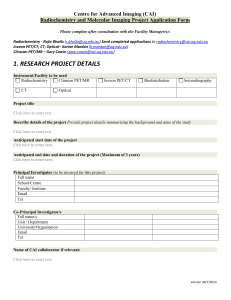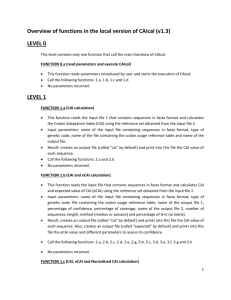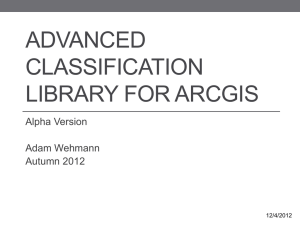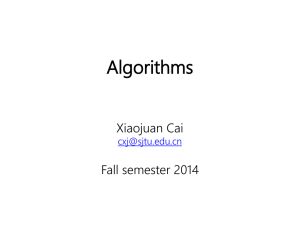Environmental Monitoring of Primary Engineering Controls
advertisement
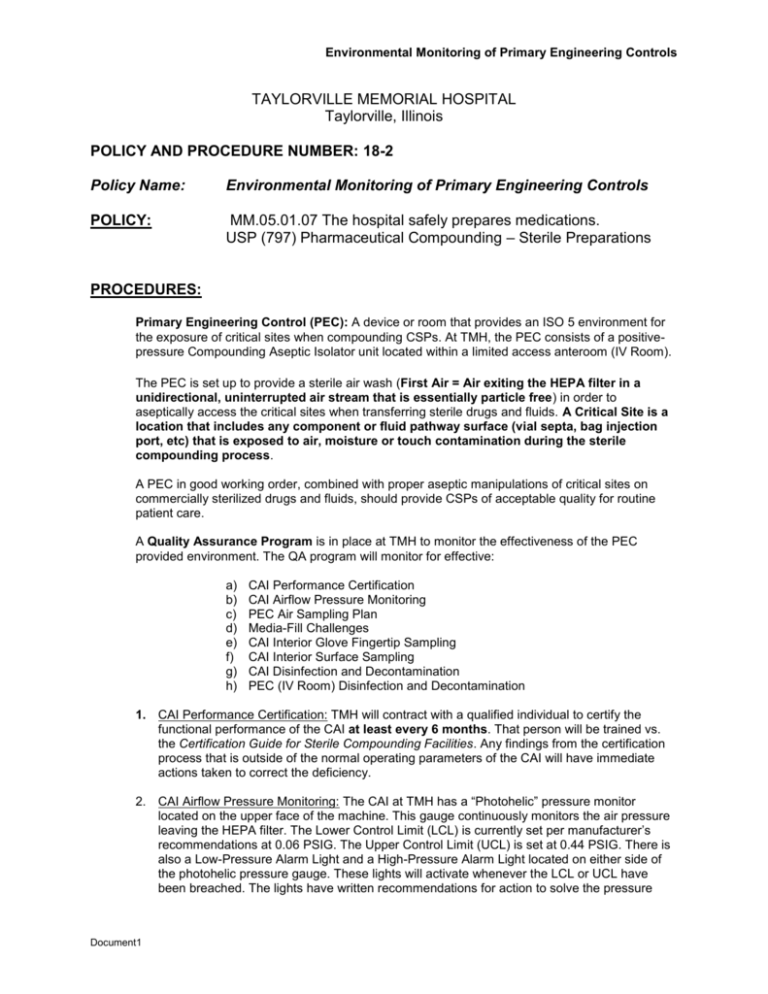
Environmental Monitoring of Primary Engineering Controls TAYLORVILLE MEMORIAL HOSPITAL Taylorville, Illinois POLICY AND PROCEDURE NUMBER: 18-2 Policy Name: Environmental Monitoring of Primary Engineering Controls POLICY: MM.05.01.07 The hospital safely prepares medications. USP (797) Pharmaceutical Compounding – Sterile Preparations PROCEDURES: Primary Engineering Control (PEC): A device or room that provides an ISO 5 environment for the exposure of critical sites when compounding CSPs. At TMH, the PEC consists of a positivepressure Compounding Aseptic Isolator unit located within a limited access anteroom (IV Room). The PEC is set up to provide a sterile air wash (First Air = Air exiting the HEPA filter in a unidirectional, uninterrupted air stream that is essentially particle free) in order to aseptically access the critical sites when transferring sterile drugs and fluids. A Critical Site is a location that includes any component or fluid pathway surface (vial septa, bag injection port, etc) that is exposed to air, moisture or touch contamination during the sterile compounding process. A PEC in good working order, combined with proper aseptic manipulations of critical sites on commercially sterilized drugs and fluids, should provide CSPs of acceptable quality for routine patient care. A Quality Assurance Program is in place at TMH to monitor the effectiveness of the PEC provided environment. The QA program will monitor for effective: a) b) c) d) e) f) g) h) CAI Performance Certification CAI Airflow Pressure Monitoring PEC Air Sampling Plan Media-Fill Challenges CAI Interior Glove Fingertip Sampling CAI Interior Surface Sampling CAI Disinfection and Decontamination PEC (IV Room) Disinfection and Decontamination 1. CAI Performance Certification: TMH will contract with a qualified individual to certify the functional performance of the CAI at least every 6 months. That person will be trained vs. the Certification Guide for Sterile Compounding Facilities. Any findings from the certification process that is outside of the normal operating parameters of the CAI will have immediate actions taken to correct the deficiency. 2. CAI Airflow Pressure Monitoring: The CAI at TMH has a “Photohelic” pressure monitor located on the upper face of the machine. This gauge continuously monitors the air pressure leaving the HEPA filter. The Lower Control Limit (LCL) is currently set per manufacturer’s recommendations at 0.06 PSIG. The Upper Control Limit (UCL) is set at 0.44 PSIG. There is also a Low-Pressure Alarm Light and a High-Pressure Alarm Light located on either side of the photohelic pressure gauge. These lights will activate whenever the LCL or UCL have been breached. The lights have written recommendations for action to solve the pressure Document1 Environmental Monitoring of Primary Engineering Controls problem written on the label below the light. The pharmacy staff will document the operating pressure daily at the beginning of the CSP shift. Documentation will occur on the PEC Environmental Monitoring Log (PECLog). Action will be taken by the pharmacy in response to any breach of the LCL or UCL or upon activation of either alarm lights. Documentation of these actions will occur on the PECLog. 3. PEC Air Sampling Plan: TMH monitors for airborne viable particles WITHIN the CAI. When functioning properly, the CAI will maintain ISO 5 air quality within the compounding area and antechamber regardless of the outside air quality. Air quality OUTSIDE of the CAI will be controlled by cleaning, disinfecting and decontamination procedures, but not routinely tested for viable particles. Air sampling will be performed twice annually (and more frequently if other environmental monitors suggest) in conjunction with the CAI Performance Certification testing. The results of the tests will be documented in the PEClog. Any result exceeding an upper control limit shall be acted upon and re-tested until control is regained. Actions will be documented on the air sampling log. 4. Media-Fill Challenges: TMH will require each person responsible for the compounding of sterile products within a CAI to complete a media-fill challenge successfully. This test will be performed successfully at the time of hire, at least annually after hire and upon a failure of any of the other environmental monitoring functions which would suggest a break in technique. The media-fill challenge will consist of a commercially-prepared kit with written procedures for the completion of the tests. The resultant cultures will be incubated per procedures and monitored and documented by the Pharmacy Manager. The media-fill test procedure will be visually monitored by the Pharmacy Manager (or designee) and will constitute a verification of the personnel’s aseptic technique abilities. Any failure of the challenge will cause the test to be redone until a satisfactory result is obtained. The documents from these testing procedures will be filed with the employee’s annual performance evaluation papers. 5. CAI Interior Glove Fingertip Sampling: TMH will perform periodic (at least 2x/year) interior glove fingertip sampling tests to ensure the sterility of the interior environment remains within intended limits. This test will consist of a culture of the right first and fourth fingers and the left second and third fingers. The cultures will be placed on a commercially-prepared tryptic soy agar plate designed for that purpose. The culture will be inoculated on the disk as follows: right 1 to the upper left quadrant, right 4 to the upper left quadrant, left 2 to the lower left quadrant and left 3 to lower right quadrant (as plate is facing the tester). The testing will be carried out on gloves AFTER a standard disinfecting process has been performed. ANY subsequent growth will be considered a test failure (no growth considered a “pass”). A test failure will require a change of gloves and a re-challenge. Consecutive sampling failures will require a review of systems and an action plan. 6. CAI Interior Surface Sampling: TMH will perform periodic (at least 2x/year) CAI interior surface sampling to ensure that the environment is being adequately disinfected and decontaminated. The procedure will consist of 3 cultures of the interior CAI surface using commercially-prepared tryptic soy agar plates. The plates will be inoculated as follows: #1 plate = upper left CAI surface, #2 = center middle CAI surface, #3 = lower right CAI surface (as seen from tester). The testing shall be completed immediately after a proper disinfecting of the CAI via procedure. ANY growth on any plate shall be considered a CAI test failure. The surface shall be disinfected again and re-tested. Consecutive testing failures will require a system review and action plan. Any growth noted will be sent to the TMH lab to attempt to identify/classify the organism. Any results of that classification will be noted on the final test report. All actions and results from the testing shall be noted on the sampling report and filed per procedure. Document1 Environmental Monitoring of Primary Engineering Controls 7. CAI Routine Disinfection Process: The interior surface of the CAI, interior gloves/sleeves and the interior antechamber surface shall be disinfected periodically. The procedure is required to be performed a.) at the beginning of the compounding day b.) periodically throughout the compounding process c.) immediately after any breach of CAI containment and d.) after any spill within the CAI environment. The daily disinfection procedures are documented on the PECLog, with subsequent disinfections considered part of the routine daily operations and do not require documentation. 8. CAI Routine Decontamination Process: The interior surface of the CAI, interior gloves/sleeves and the interior antechamber surface shall be decontaminated periodically. The CAI will be decontaminated 3 times weekly on Mondays, Wednesdays, and Fridays. The decontamination of the surfaces will be performed using a commercially-prepared product designed for CAI decontamination (Maxima RTU Aseptic Enclosures). The product is a quaternary disinfectant with staphylocidal, pseudomonacidal, virucidal, fungicidal and mildewcidal properties. Decontamination efforts will be documented via the PEC log. 9. PEC Disinfection and Decontamination: The walls, floors, countertops, shelving units and other items allowed in the IV-Room shall be disinfected and decontaminated periodically by the pharmacy staff. This shall be done weekly (usually a Wednesday, but flexible as staffing allows) and documented via the PEC log. The decontamination of the surfaces will be performed using a commercially-prepared product designed for CAI decontamination (Maxima RTU Aseptic Enclosures). The product is a quaternary disinfectant with staphylocidal, psudomonacidal, virucidal, fungicidal and mildewcidal properties. Disinfection and decontamination efforts will also be performed in response to a spill or other event thought to potentially compromise the environmental integrity. References: USP-NF General Chapter <797> Pharmaceutical Compounding – Sterile Preparations Aseptic Enclosures – Operating and Maintenance Instructions ____________________________ Don Schaeffer Manager, Pharmacy Document1 February 2013 November 2013 (est) (review)

